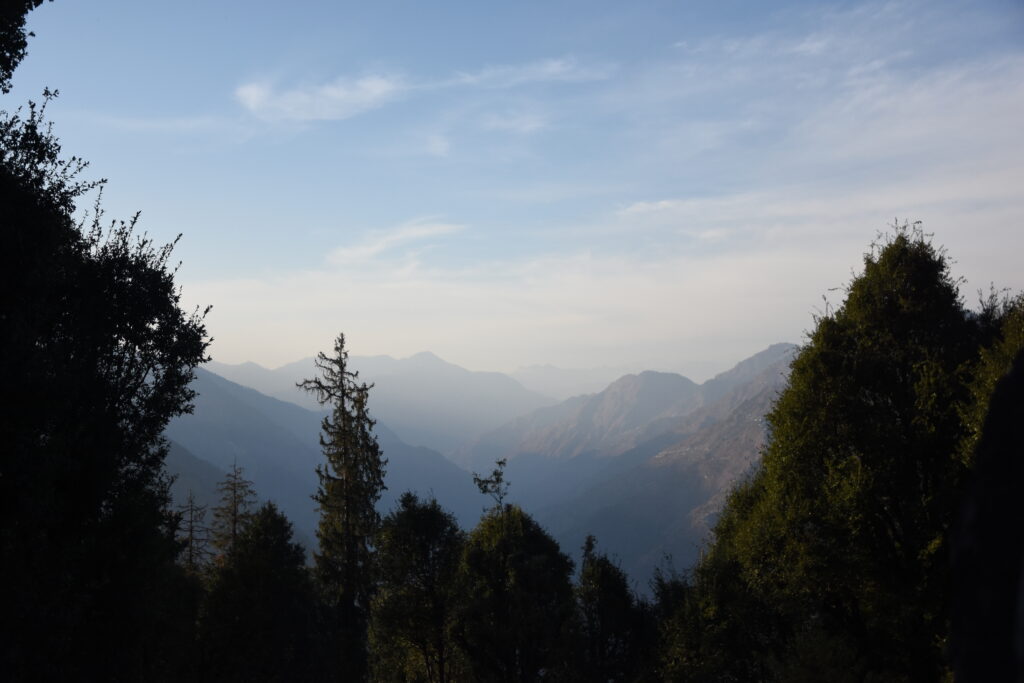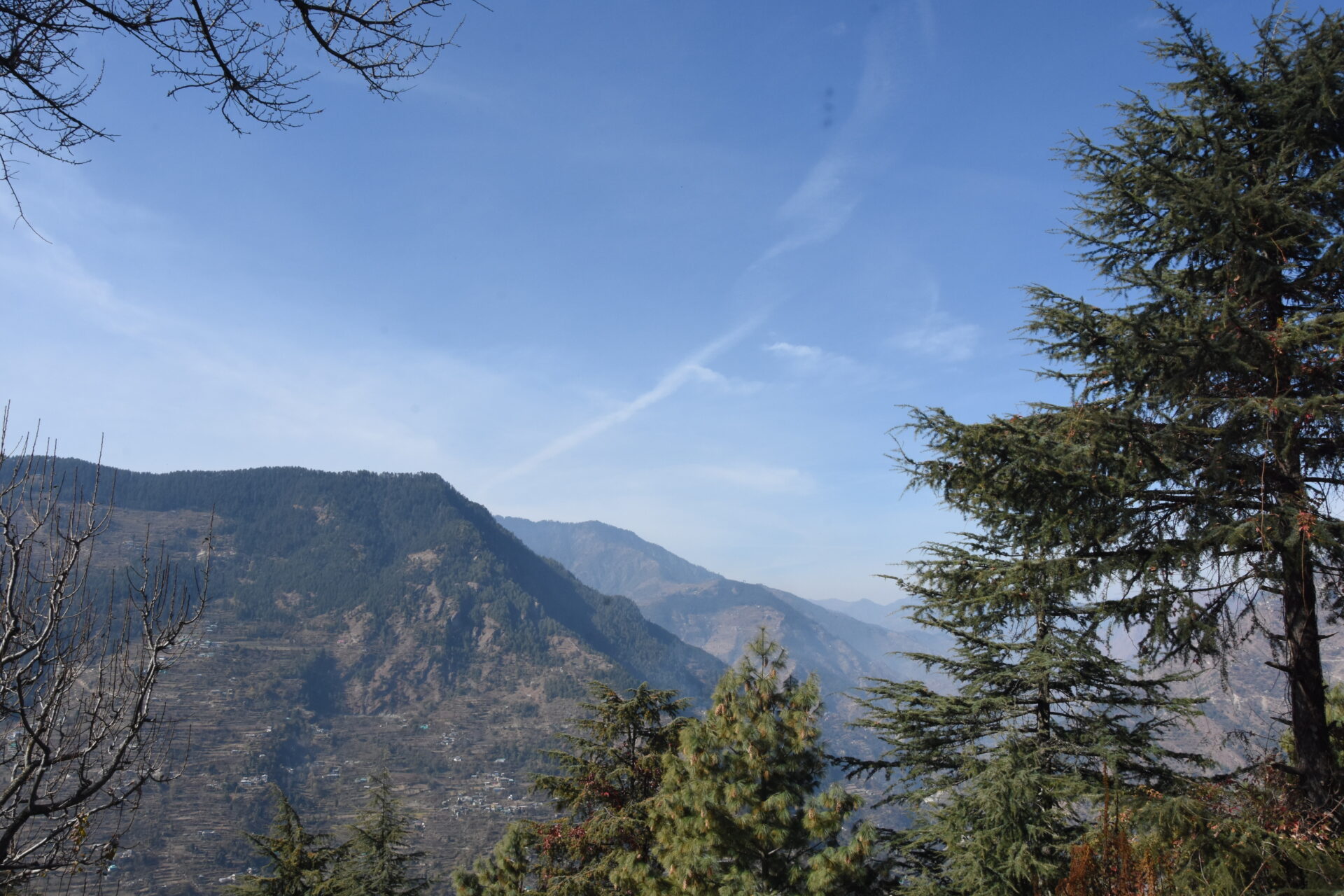Up in the Himalayas, lives an Indo-French family. Aniq, Janeesha, Reena, and Stephan reside in their Kaathkuni house (Eagle Nest), calling the mountains their home for over ten years now. No wonder, if you know any of the three languages among Hindi, French and English, you will have a good time with the family, and if you are lucky, will also learn bird and monkey language from Aniq! I was lucky to have stayed and walked their backyard with them – the one that gives a daunting 360 view of Tirthan and Jibhi valley, Tirth river and is protected by the Dhauladhar ranges in the far end. With a small team along with the family, they run Himalayan Ecotourism (HET) which has been awarded countless awards for their work and the values with which they operate within the valley and beyond. I thoroughly enjoyed spending time with the few members I met, Prachiti and Sonali, and learnt so much about them and their outlook about things.
Over endless cups of Chai, we had lovely chatter and conversations about the place, challenges, and the work they do with the local community. We went for few short hikes that were no less of a great lesson in the woods for myself.

A few meters from their house is a tiny village Bihar with not more than 120 inhabitants. While crossing the village, we greeted one and all, each busy in their morning affairs – kids walking to school, some sorting corn and letting them sunbathe for a wholesome ‘makke-di-roti, sarson-da-saag’ lunch (Stephan of course self-invited himself to the occasion), some sunbathing themselves, some carrying fodder across the village, and the animals lazing around the sunny winter day. We also stopped by a hay-house to see the newly born baby pups and played with them while Janeesha and Aniq argued if they should adopt them all! As we hiked further into the woods, we walked past fern and acorn trees, numerous Deodar and Cedar, and Oak trees, while Janeesha collected souvenirs from the walk in a tiny basket to later showcase it on their entrance table at Eagle Nest. As we approached a good view point, we couldn’t help but acknowledge the smoke-belching mountain top that was actually a forest fire!


“This, you see, is a dying forest. Such forest fires prevent the young trees from growing”, Stephan told us, while taking pictures of the incident to report to the forest department. People burn patches of forest for various reasons. Despite knowing that burning forest patches is wrong, there is an acceptance around this; – the poor may have burnt the patch for some use. Burning helps locals collect wood, fodder, and other forest produce with ease. For instance, collecting Gucci – a type of mushroom which has a large demand in the Indian and foreign market and earns the villagers handsome money. The societal construct to constantly need money to make ends meet ensures forest fires to have become a very common occurrence in the valley. ‘There is no patch of forest that is left un-burnt in this valley and all these fires are man-made!’. Standing there itself, we spotted some more forest fire sites that were active at the time in the neighboring mountains. He helped us spot the different kinds of mountain covers around us – pasteur lands, dense pine forests, meadows, and not-so-dense forests and explained to us that these are predominantly an aftermath of concentrated forest fires for different human use (like grazing cattle, and collection of forest resources).


While we were flooding Stephan with questions around the concern of forest fires and the urgency for forest conservation, a gallant Himalayan Griffin graced us with a great flight across our visible skies and easily took away the heat of the moment, as if telling us that the skies and forests are theirs first, and the animals and birds also seek answers in this debate!


Stephan has been in the valley for over ten years now, and this has helped him not only understand some of the challenges but also untangle the interlinkages among them. He has also spent time getting to know the locals and speaking with various authorities. As Stephan would say it, he has ‘catalyzed’ the formation of a community-centered cooperative composed of 65 members who are from the ecozone of the Great Himalayan National Park. While the cooperative shares the responsibilities of the trekking flux to the Park (through them), they also plan reforestation drives closer to the Park, ensuring further safety to the World Heritage Site (the Park!). The integration of the conservation activities and awareness of forest fires with the community plays a central role in its success. With setting up the cooperative, they have been able to do a lot of good work together. In 2021, with the support of Himalayan Ecotourism, they organized awareness camps for forest fires where they educated all locals including children, women, and the elderly about the cause, and also mobilized resources to reforest a patch of the valley. ‘It was a grand success and we did not see any fires until the pandemic hit us’, Stephan told us. The HET team is once again planning to initiate an awareness and reforestation drive which will seek ways to raise funds for the same. The campaign, called ‘Roots for the Future’, aims for awareness generation among locals about forest fires and forest conservation, reforestation drive, and women empowerment.
The community looks after the reforested patch and ensures that it remains healthy. They only plant indigenous plants that will do well in the patch. They are planning to plant fruit trees to prevent animals from coming closer to human settlements. Learning about their work, I realized that organizing such events is not easy, and definitely not a one-day’s job. It takes days and months to plan and prepare. Currently, they are on step one of the process, if I may put it that way, and are preparing for the fundraiser with immense enthusiasm so as to have greater impact.
Amidst these conversations, we realized it was lunch time soon and that we must head back. Janeesha was busy being awed by her friends, the wild! She showed us her now basket-full of collectibles – pine cones, leaves of various kinds and colours, feathers, porcupine spikes, flowers and many more incredible things. Meanwhile her brother Aniq had meticulously worked on creating his own mountain from pine (flower?) shavings and was protecting it against the breeze that would have otherwise blown them away. He had made it with such love, care and patience and was resisting moving away from his mountain.


To this, Stephan remarked, “You made it, but you have to let it go. It is beautiful but you have to let it go”.
…
Please consider going onto this link and check the campaign released by the Himalayan Ecotourism team.
If you also feel for this, and would like to contribute for the campaign, please consider going to their fundraiser linked here.





